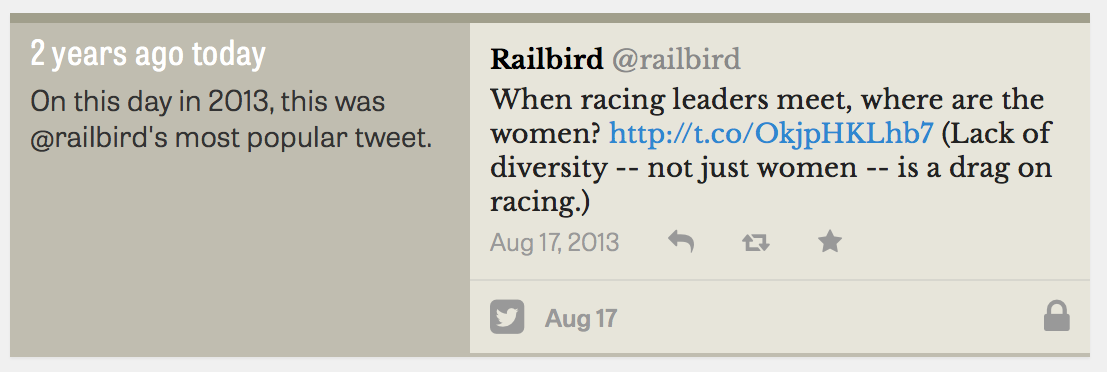Jockey Club

Two years ago, Teresa Genaro wrote about the poor representation of women in racing. She’s back this week with an update of little progress, in a Pink Sheet column that concludes with this indictment:
Yet when it comes to putting panels together, or hiring executives, or filling board vacancies, women seem to be elusively difficult to find.
If the problem is a dearth of women on leadership pathways in the industry, current executives should be asking themselves why, and what they are doing to cultivate women and bring them into the sport, as other industries have long done and continue to do.
Instead, racing seems content, for the most part, to pander to stereotypes, to view women as decorations rather than as customers, and to overlook them when putting people in front of microphones and in board rooms.
How many times does this have to be said? (That’s a rhetorical question.) How can we do better? (That’s not.) The issue isn’t specific to racing — it regularly flares up in media and technology (the other industries I closely follow). Does racing need some equivalent of the VIDA Count? (Would be just a start.)
To anyone who scoffs that diversity matters, know this — diversity drives market growth. As the American population becomes more diverse, diversity is only going to increase in importance to any industry’s long-term survival.
Related: “NYRA Board less diverse than GOP primary field.”
Several weeks ago, in a post called “The Invisible Sport,” Jennifer Wirth of the Saturday Post inspired a campaign to increase mainstream media coverage of horse racing. A worthy goal, but as the reaction to Joe Drape’s New York Times story on the the Thoroughbred Retirement Foundation shows, it’s the whole industry that’s largely invisible, not just the sport.
Outside of Kentucky and New York, there aren’t many non-trade publications covering the larger stories of racing business and politics, and outside of the New York Times, almost none doing investigative work.
Vic Zast runs down the reasons for the lack of horse racing coverage in his HRI column today. All are familiar (fewer reporters, reduced resources, turf writers “captured” by sources), but that doesn’t make the problem any less an issue.
Wirth argues that racing won’t last if people aren’t exposed to the game and its stars through news stories; it also won’t last without press oversight, exposing serious issues and compelling change. Whatever the debatable flaws in Drape’s work, his reporting is necessary, and racing needs more of it.
3:15 PM Addendum: Writing on the Atlantic, Andrew Cohen reacts to the TRF story. “No matter who is at fault, no matter what happens to the TRF from here, please, someone, take care of those poor damned horses.” It seems like there should be a mechanism, some simple way to gather small sums for retirement funds — something like the Jockey Club check-off program, made mandatory. An an opt-in program, it isn’t attracting much support.
Dr. Rick Arthur tells the Paulick Report:
… the next steps for the Equine Injury Database is a peer-reviewed study by [Dr. Tim Parkin] that could examine many other risk factors: class drops, pedigree, workout patterns, the distribution of injuries, the correlation between injuries and bumping or clipping heels during a race, whether or not horses injured during a race were on a vet’s list.
“We’ll be looking at a lot of the risk factors and try to figure out if there are any strategies that can make racing safer,” he said. “We have all the information that Equibase has, and all the information that the regulatory vets are collecting, including information on injuries that were not fatal. It’s going to be a very powerful tool.”
Copyright © 2000-2023 by Jessica Chapel. All rights reserved.